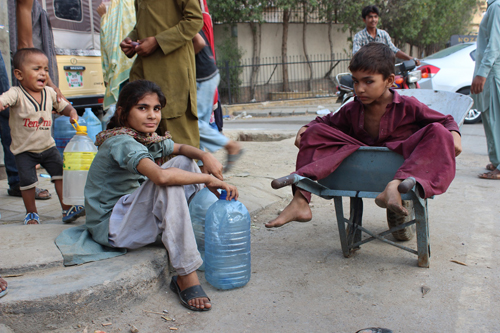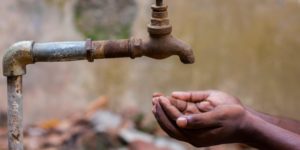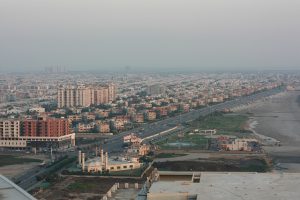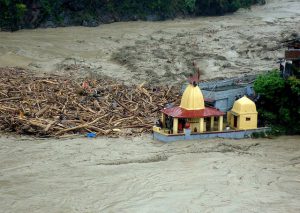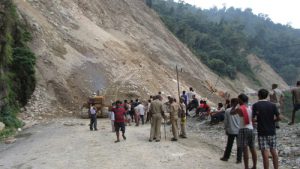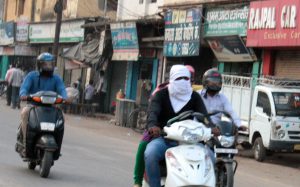As last week’s heatwave death toll in Pakistan’s largest city crossed 1,200, and there was no sign of the monsoon rain promised by the weatherman, some experts warned of another heatwave in the offing. Mercifully, the Pakistan Meteorological Department refuted the claim.
After a blistering week, Karachi, a city of an estimated 20 million people, saw the maximum temperature dropping from 49 degrees Celsius to 37. The breeze from the Arabian Sea is back.
While some scientists have linked the heat wave to climate change, many others are reluctant to do so. Asked if there was a link, Adil Najam – dean of the Pardee School of Global Studies at Boston University – said, “The honest answer, nearly always, is no, not entirely.” But, he added, “Climate change exacerbates existing threats and so what might have been manageable in the normal course of things becomes unmanageable with climate change.”
Saleem H. Ali, chair in Sustainable Resources Development of University of Queensland in Brisbane, said, “Climate change is measured in aggregate terms and not through episodic weather occurrences.”
Najam, who has been among the lead authors of the third and fourth assessment reports of the Intergovernmental Panel on Climate Change (IPCC), also said there have been many heatwaves, droughts, floods and so on in the past, some of them really bad. But, “What climate change does is that it adds to these threats by increasing their likelihood, or frequency or ferocity.”
Heatwave took authorities by surprise
The scientists’ warning makes it clear that Karachi needs to prepare for more heatwaves. The recent heatwave showed how unprepared the authorities were.
While every resident suffered from the urban heat island effect, those who died were the poorest, weakest and most vulnerable. Jam Mahtab, Sindh’s health minister, said that 35% of those who died were women, while 25% were street dwellers.
“The loss in Karachi has been horrendous not just because the heat was unbearable, but because the city and particularly its poorest residents were so very ill-equipped to deal with its impacts,” said Najam, adding that Karachi was a perfect example of “what an unresilient city looks like.” Extreme poverty, bad urban infrastructure, poor development and poor governance compounded the climate crises exponentially, he said.
The heatwave has also shown the indifference and ineptitude of the government.
“Opposition leader Imran Khan visited the hospital, so did Sindh chief minister and the province’s ruling party chairman Bilawal Bhutto; I don’t know what happened after that,” said Jibran Nasir, a young lawyer and social activist who has been able to mobilize a cohort of young people to work at two of Karachi’s biggest government-run hospitals – the Jinnah Postgraduate Medical Centre and the Civil Hospital – where they work from 10 in the morning to 10 in the night despite this being the month of Ramzan.
Had the citizens of Karachi not stepped in to fill the gap where government services were unavailable, many more would have died. “The extra hands came in very handy for simple cooling and rehydration efforts,” said Tasnim Ahsan of the Jinnah Postgraduate Medical Centre (JPMC).
The volunteers have not only offered their time, but provided many things the hospitals needed – from oral rehydration solutions to bottled water, juice, ice blocks, towels, sheets and even janitorial services.
“They even managed to get donations for chillers, air conditioners and generators to run them. Where we had ACs which were not working, they got them fixed,” Ahsan said. “All these measures should have been put in place by the government through its emergency measures which were conspicuous by their absence during this time.”
According to Nasir, “The least the government could have done, and can do even now, is to put up marquees around town, at busy intersections to provide people with some shade. They could have put tubs of water and if that was not possible, put empty tubs and asked the citizens to donate some water.”

Good governance to fight climate fury
Saleem Ali pointed out that better governance would not have brought the temperatures down, but the casualties could have been minimized. He said public education on the importance of drinking water, to ask labourers to stay indoors in peak heat hours, encouraging the use of traditional clay and adobe architecture rather than hot concrete buildings was not only the government’s responsibility but also of community organizations such as mosques as well as people who hire labourers.
“We are informing people about the coming week’s weather forecast and educating them on what steps to take to protect themselves,” said Nasir, adding, “The government can do the same – on billboards, public service announcements on TV and radio.”
“Good governance is not a cure for dehydration, but good governance provides citizens with the means to deal with – and avoid – dehydration,” Najam said. “The very purpose of good governance, especially good governance for climate change, is to be able to give a meaningful safety net to those who are the poorest, the weakest and the most vulnerable.”
To fight weather furies, Ali suggested a more collective approach. “It is high time Pakistan approach such matters with collective responsibility rather than making such tragedies an opportunity for blame games. Lessons should be learned by public and private institutions on adapting to extreme heat and cold stress (in areas) with high population density.”
Today many urban planners and environmentalists says high temperatures can be managed by including a greater amount of open and green space in cities, providing shady spots (in the form of indigenous trees) and water fountains, and going back to vernacular architecture – ventilators, high ceilings and so on.
Planning for a changed climate
A recent study of 217 cities around the globe – led by Vimal Misra of Indian Institute of Technology, Gandhinagar – shows that in a heatwave situation, urban areas will be worse off than villages.
What is of urgency today is for governments to focus on adaptation efforts to reduce the death, damage and destruction caused by extreme weather events. Najam said, “Developing countries have to prepare to adapt to climate change themselves.”
Ali said: “Human societies have the ability to adapt to many extreme events as long as they plan and have the resources to cope.”
Najam does not want to see another policy document as the government’s response. “We already have enough and all are equally uninspiring in what they want to do and equally ineffectual in what they have actually done.”
What the scientist would much rather see is Pakistan waking up to the realization that the real solutions to all its crises are “solutions of development, solutions of better governance, solutions of sustainability.” The focus, he said, should be on making cities more resilient and making communities more sustainable.
